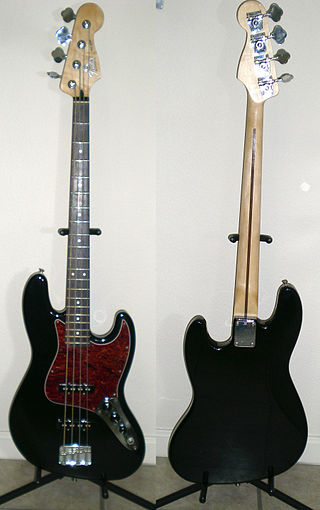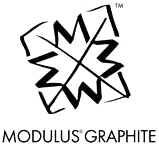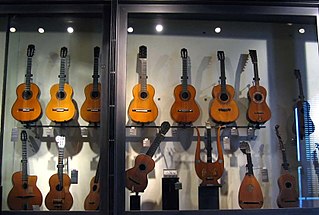
The guitar is a stringed musical instrument that is usually fretted and typically has six or twelve strings. It is usually held flat against the player's body and played by strumming or plucking the strings with the dominant hand, while simultaneously pressing selected strings against frets with the fingers of the opposite hand. A guitar pick may also be used to strike the strings. The sound of the guitar is projected either acoustically, by means of a resonant hollow chamber on the guitar, or amplified by an electronic pickup and an amplifier.

A fret is any of the thin strips of material, usually metal wire, inserted laterally at specific positions along the neck or fretboard of a stringed instrument. Frets usually extend across the full width of the neck. On some historical instruments and non-European instruments, frets are made of pieces of string tied around the neck.
The fingerboard is an important component of most stringed instruments. It is a thin, long strip of material, usually wood, that is laminated to the front of the neck of an instrument. The strings run over the fingerboard, between the nut and bridge. To play the instrument, a musician presses strings down to the fingerboard to change the vibrating length, changing the pitch. This is called stopping the strings. Depending on the instrument and the style of music, the musician may pluck, strum or bow one or more strings with the hand that is not fretting the notes. On some instruments, notes can be sounded by the fretting hand alone, such as with hammer ons, an electric guitar technique.

Michael Manring is an American bass guitarist from the San Francisco Bay Area.

A fretless guitar is a guitar with a fingerboard without frets, typically a standard instrument that has had the frets removed, though some custom-built and commercial fretless guitars are occasionally made. The classic fretless guitar was first pioneered in 1976 by Turkish musician Erkan Oğur. Fretless bass guitars are readily available, with most major guitar manufacturers producing fretless models.

The Fender Precision Bass is a model of electric bass guitar manufactured by Fender Musical Instruments Corporation. In its standard, post-1957 configuration, the Precision Bass is a solid body, four-stringed instrument usually equipped with a single split-coil humbucking pickup and a one-piece, 20-fret maple neck with rosewood or maple fingerboard.

The Fender Jazz Bass is the second model of electric bass created by Leo Fender. It is distinct from the Precision Bass in that its tone is brighter and richer in the midrange and treble with less emphasis on the fundamental frequency. The body shape is also different from the Precision Bass, in that the Precision Bass has a symmetrical lower bout on the body, designed after the Telecaster and Stratocaster lines of guitars, while the Jazz Bass has an offset lower bout, mimicking the design aesthetic of the Jaguar and Jazzmaster guitars.

Jazz bass is the use of the double bass or electric bass guitar to improvise accompaniment ("comping") basslines and solos in a jazz or jazz fusion style. Players began using the double bass in jazz in the 1890s to supply the low-pitched walking basslines that outlined the chord progressions of the songs. From the 1920s and 1930s Swing and big band era, through 1940s Bebop and 1950s Hard Bop, to the 1960s-era "free jazz" movement, the resonant, woody sound of the double bass anchored everything from small jazz combos to large jazz big bands.
Steinberger is a series of distinctive electric guitars and bass guitars, designed and originally manufactured by Ned Steinberger. The name "Steinberger" can be used to refer to either the instruments themselves or the company that originally produced them. Although the name has been applied to a variety of instruments, it is primarily associated with a minimalist "headless" design of electric basses and guitars.

A fretless bass is an electric bass guitar whose neck lacks frets and thus is smooth like traditional string instruments, and like the neck of an acoustic double bass. While the fretless bass is played in all styles of music, it is most common in pop, rock, and jazz. It first saw widespread use during the 1970s, although some players used them before then.

Modulus Graphite is an American manufacturer of musical instruments best known for building bass guitars with carbon fiber necks. The company, originally called Modulus Graphite, was founded in part by Geoff Gould, a bassist who also worked for an aerospace company in Palo Alto, California, and coworker Jerry Dorsch. When they split, Jerry started Graphite Guitar Systems in Washington state.
An extended-range bass is an electric bass guitar with a wider frequency range than a standard-tuned four-string bass guitar.

The following outline is provided as an overview of and topical guide to guitars:

A multi-neck guitar is a guitar that has multiple fingerboard necks. They exist in both electric and acoustic versions. Examples of multi-neck guitars and lutes go back at least to the Renaissance.
Lakland Guitars is an American manufacturer of electric bass guitars based in Chicago, Illinois. The company's first bass combined elements of the Fender Jazz Bass and the Music Man StingRay. The company's current line-up includes basses inspired by classics like the Fender Precision Bass and Jazz Bass as well as Lakland's own original designs. Lakland's line of signature models includes basses designed in collaboration with well-known bassists Joe Osborn, Donald "Duck" Dunn, Jerry Scheff, Darryl Jones and Bob Glaub. Lakland basses are manufactured in the United States, Japan, South Korea, and Indonesia.

Vigier Guitars is a French musical instruments company based in Grigny, Essonne and founded by Patrice Vigier in 1980. In addition to manufacturing, the company is also active in the import and wholesale distribution of musical instruments, amplifiers and accessories through its division High Tech Distribution.
The Fender American Deluxe Series was a line of electric guitars and basses introduced by Fender in 1995 and discontinued in 2016. It was upgraded in 2004 and 2010 before being replaced by the American Elite series in 2016.
Jens Ritter Instruments is a manufacturer of high-end electric string instruments. It was founded by Jens Ritter in the mid-1990s and was known as Ritter Bass Guitars until 2010 when Jens expanded his line to include guitars. Jens produces 50 to 60 handmade instruments each year in his shop located in the small wine town of Deidesheim,Germany.
The Yamaha Corporation is a multinational corporation and conglomerate based in Japan with a wide range of products and services, predominantly musical instruments, motorcycles, power sports equipment and electronics.

Dingwall Designer Guitars is a manufacturer of bass guitars and electric guitars based in Saskatoon, Saskatchewan, Canada. It employs the fanned-fret system started by Novax Guitars for manufacturing basses, increasing the scale length of the strings on the bass side of the guitar compared to the treble side. This design is more akin to a piano or harp, giving the bass strings length that increases the sustain.















